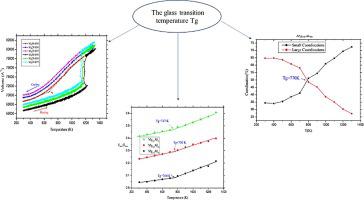当前位置:
X-MOL 学术
›
Comp. Mater. Sci.
›
论文详情
Our official English website, www.x-mol.net, welcomes your
feedback! (Note: you will need to create a separate account there.)
Structural and mechanical behaviors of Mg-Al metallic glasses investigated by molecular dynamics simulations
Computational Materials Science ( IF 3.1 ) Pub Date : 2020-11-01 , DOI: 10.1016/j.commatsci.2020.109895 A. Samiri , A. Khmich , H. Haouas , A. Hassani , A. Hasnaoui
Computational Materials Science ( IF 3.1 ) Pub Date : 2020-11-01 , DOI: 10.1016/j.commatsci.2020.109895 A. Samiri , A. Khmich , H. Haouas , A. Hassani , A. Hasnaoui

|
Abstract Using molecular dynamics simulations with the embedded atomic method (EAM) to describe interatomic interactions, structural and mechanical properties of Mg-Al metallic glasses (MG) have been investigated for different compositions. The atomic structure is characterized using various techniques such as the Radial Distribution Function (RDF), the Voronoi Tessellation Analysis (VTA) and coordination number (CN) distribution. The results confirmed that the Mg-Al glass formation is accompanied by a splitting of the RDF second peak upon cooling process. The glass transition temperature is determined using different method involving a new suggested way consisting of the cross-over between low and high coordination numbers curves during cooling process. This last technique gives approximate results that converge to those given by classical methods. On the other hand, we applied a strain-rate of 1010 s−1 at 300 K and showed that with the increase of Al composition, the maximal stress increases as a function of strain. For a fixed composition of Mg-Al MG, the yield strength increases with the increase of strain-rate between 109 s−1 and 1010 s−1. The impact of temperature on the mechanical behaviour of Mg-Al under various strain-rates has been investigated and the result suggests that for the same applied strain-rate, the ultimate tensile strength decreases as a function of temperature. Finally, the annealing effect has led to a softening of elastic moduli especially the Young modulus (E) which has been determined through both elastic constants Cij and from the stress–strain curve.
中文翻译:

通过分子动力学模拟研究 Mg-Al 金属玻璃的结构和力学行为
摘要 使用嵌入原子方法 (EAM) 的分子动力学模拟来描述不同成分的 Mg-Al 金属玻璃 (MG) 的原子间相互作用、结构和机械性能。使用各种技术表征原子结构,例如径向分布函数 (RDF)、Voronoi 镶嵌分析 (VTA) 和配位数 (CN) 分布。结果证实,Mg-Al 玻璃的形成伴随着冷却过程中 RDF 第二峰的分裂。玻璃化转变温度是使用不同的方法确定的,该方法涉及一种新的建议方法,包括冷却过程中低配位数曲线和高配位数曲线之间的交叉。最后一种技术给出的近似结果收敛于经典方法给出的结果。另一方面,我们在 300 K 下应用了 1010 s-1 的应变率,并表明随着 Al 成分的增加,最大应力随应变而增加。对于固定成分的 Mg-Al MG,屈服强度在 109 s-1 和 1010 s-1 之间随着应变速率的增加而增加。已经研究了温度对不同应变速率下 Mg-Al 机械行为的影响,结果表明,对于相同的应用应变速率,极限抗拉强度随温度的变化而降低。最后,退火效应导致弹性模量软化,尤其是杨氏模量 (E),它是通过弹性常数 Cij 和应力-应变曲线确定的。另一方面,我们在 300 K 下应用了 1010 s-1 的应变率,并表明随着 Al 成分的增加,最大应力随应变而增加。对于固定成分的 Mg-Al MG,屈服强度在 109 s-1 和 1010 s-1 之间随着应变速率的增加而增加。已经研究了温度对不同应变速率下 Mg-Al 机械行为的影响,结果表明,对于相同的应用应变速率,极限抗拉强度随温度的变化而降低。最后,退火效应导致弹性模量软化,尤其是杨氏模量 (E),它是通过弹性常数 Cij 和应力-应变曲线确定的。另一方面,我们在 300 K 下应用了 1010 s-1 的应变率,并表明随着 Al 成分的增加,最大应力随应变而增加。对于固定成分的 Mg-Al MG,屈服强度在 109 s-1 和 1010 s-1 之间随着应变速率的增加而增加。已经研究了温度对不同应变速率下 Mg-Al 机械行为的影响,结果表明,对于相同的应用应变速率,极限抗拉强度随温度的变化而降低。最后,退火效应导致弹性模量软化,尤其是杨氏模量 (E),它是通过弹性常数 Cij 和应力-应变曲线确定的。最大应力随应变而增加。对于固定成分的 Mg-Al MG,屈服强度在 109 s-1 和 1010 s-1 之间随着应变速率的增加而增加。已经研究了温度对不同应变速率下 Mg-Al 机械行为的影响,结果表明,对于相同的应用应变速率,极限抗拉强度随温度的变化而降低。最后,退火效应导致弹性模量软化,尤其是杨氏模量 (E),它是通过弹性常数 Cij 和应力-应变曲线确定的。最大应力随应变而增加。对于固定成分的 Mg-Al MG,屈服强度在 109 s-1 和 1010 s-1 之间随着应变速率的增加而增加。已经研究了温度对不同应变速率下 Mg-Al 机械行为的影响,结果表明,对于相同的应用应变速率,极限抗拉强度随温度的变化而降低。最后,退火效应导致弹性模量软化,尤其是杨氏模量 (E),它是通过弹性常数 Cij 和应力-应变曲线确定的。已经研究了温度对不同应变速率下 Mg-Al 机械行为的影响,结果表明,对于相同的应用应变速率,极限抗拉强度随温度的变化而降低。最后,退火效应导致弹性模量软化,尤其是杨氏模量 (E),它是通过弹性常数 Cij 和应力-应变曲线确定的。已经研究了温度对不同应变速率下 Mg-Al 机械行为的影响,结果表明,对于相同的应用应变速率,极限抗拉强度随温度的变化而降低。最后,退火效应导致弹性模量软化,尤其是杨氏模量 (E),它是通过弹性常数 Cij 和应力-应变曲线确定的。
更新日期:2020-11-01
中文翻译:

通过分子动力学模拟研究 Mg-Al 金属玻璃的结构和力学行为
摘要 使用嵌入原子方法 (EAM) 的分子动力学模拟来描述不同成分的 Mg-Al 金属玻璃 (MG) 的原子间相互作用、结构和机械性能。使用各种技术表征原子结构,例如径向分布函数 (RDF)、Voronoi 镶嵌分析 (VTA) 和配位数 (CN) 分布。结果证实,Mg-Al 玻璃的形成伴随着冷却过程中 RDF 第二峰的分裂。玻璃化转变温度是使用不同的方法确定的,该方法涉及一种新的建议方法,包括冷却过程中低配位数曲线和高配位数曲线之间的交叉。最后一种技术给出的近似结果收敛于经典方法给出的结果。另一方面,我们在 300 K 下应用了 1010 s-1 的应变率,并表明随着 Al 成分的增加,最大应力随应变而增加。对于固定成分的 Mg-Al MG,屈服强度在 109 s-1 和 1010 s-1 之间随着应变速率的增加而增加。已经研究了温度对不同应变速率下 Mg-Al 机械行为的影响,结果表明,对于相同的应用应变速率,极限抗拉强度随温度的变化而降低。最后,退火效应导致弹性模量软化,尤其是杨氏模量 (E),它是通过弹性常数 Cij 和应力-应变曲线确定的。另一方面,我们在 300 K 下应用了 1010 s-1 的应变率,并表明随着 Al 成分的增加,最大应力随应变而增加。对于固定成分的 Mg-Al MG,屈服强度在 109 s-1 和 1010 s-1 之间随着应变速率的增加而增加。已经研究了温度对不同应变速率下 Mg-Al 机械行为的影响,结果表明,对于相同的应用应变速率,极限抗拉强度随温度的变化而降低。最后,退火效应导致弹性模量软化,尤其是杨氏模量 (E),它是通过弹性常数 Cij 和应力-应变曲线确定的。另一方面,我们在 300 K 下应用了 1010 s-1 的应变率,并表明随着 Al 成分的增加,最大应力随应变而增加。对于固定成分的 Mg-Al MG,屈服强度在 109 s-1 和 1010 s-1 之间随着应变速率的增加而增加。已经研究了温度对不同应变速率下 Mg-Al 机械行为的影响,结果表明,对于相同的应用应变速率,极限抗拉强度随温度的变化而降低。最后,退火效应导致弹性模量软化,尤其是杨氏模量 (E),它是通过弹性常数 Cij 和应力-应变曲线确定的。最大应力随应变而增加。对于固定成分的 Mg-Al MG,屈服强度在 109 s-1 和 1010 s-1 之间随着应变速率的增加而增加。已经研究了温度对不同应变速率下 Mg-Al 机械行为的影响,结果表明,对于相同的应用应变速率,极限抗拉强度随温度的变化而降低。最后,退火效应导致弹性模量软化,尤其是杨氏模量 (E),它是通过弹性常数 Cij 和应力-应变曲线确定的。最大应力随应变而增加。对于固定成分的 Mg-Al MG,屈服强度在 109 s-1 和 1010 s-1 之间随着应变速率的增加而增加。已经研究了温度对不同应变速率下 Mg-Al 机械行为的影响,结果表明,对于相同的应用应变速率,极限抗拉强度随温度的变化而降低。最后,退火效应导致弹性模量软化,尤其是杨氏模量 (E),它是通过弹性常数 Cij 和应力-应变曲线确定的。已经研究了温度对不同应变速率下 Mg-Al 机械行为的影响,结果表明,对于相同的应用应变速率,极限抗拉强度随温度的变化而降低。最后,退火效应导致弹性模量软化,尤其是杨氏模量 (E),它是通过弹性常数 Cij 和应力-应变曲线确定的。已经研究了温度对不同应变速率下 Mg-Al 机械行为的影响,结果表明,对于相同的应用应变速率,极限抗拉强度随温度的变化而降低。最后,退火效应导致弹性模量软化,尤其是杨氏模量 (E),它是通过弹性常数 Cij 和应力-应变曲线确定的。











































 京公网安备 11010802027423号
京公网安备 11010802027423号